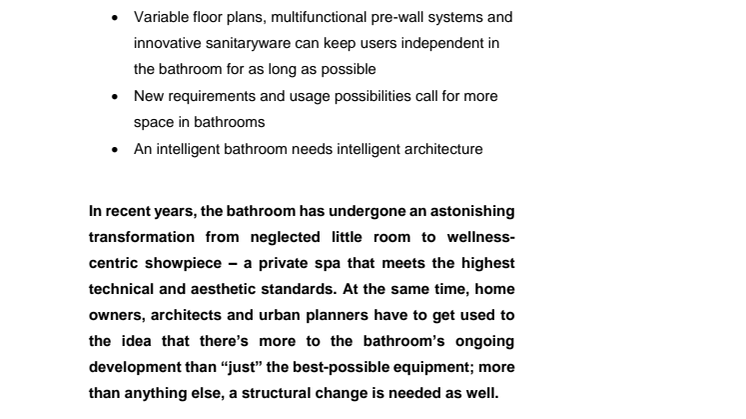Press release -
Great Times ahead for Bathrooms
- The VDS (German Sanitary Industry Association) calls for structural changes in new builds and renovation projects
- Variable floor plans, multifunctional pre-wall systems and innovative sanitaryware can keep users independent in the bathroom for as long as possible
- New requirements and usage possibilities call for more space in bathrooms
- An intelligent bathroom needs intelligent architecture
In recent years, the bathroom has undergone an astonishing transformation from neglected little room to wellness-centric showpiece – a private spa that meets the highest technical and aesthetic standards. At the same time, home owners, architects and urban planners have to get used to the idea that there’s more to the bathroom’s ongoing development than “just” the best-possible equipment; more than anything else, a structural change is needed as well.
In an individualistic society, this area of the home – a place that serves key functions such as hygiene, relationship maintenance, fitness, relaxation, pleasure, beauty and health care – has to satisfy an ever-growing number of needs.This particularly applies to barrier-free accessibility, which is crucial when it comes to ensuring that people with handicaps and the elderly can lead a self-determined life and for families with children.
In an ageing society, the independence of older generations and an easing of the burden on younger people paying into the system are prerequisites for dealing with this demographic change successfully at both social and economic level. It is therefore essential that we do not wait too long to give this mission the consideration it deserves. Germany’s sanitary industry is rising to the challenge: besides its “Barrier-free Bathroom Campaign”, it is also participating in the development of intelligent bathrooms.And yet progress still seems painfully slow when it comes to what is possibly the most important change of all: the size of the bathroom itself.
According to the data from statistical surveys, the size of the bathroom hasn’t changed for years: the average German bathroom measures 7.8 square metres.And yet its status in society and amongst users is changing dramatically.The revolution in the bathroom must therefore go hand in hand with a change in planning behaviour on the part of architects and project developers.Whilst enlarging the bathrooms of existing properties requires a great deal of effort, new builds are a different story: it is no problem at all for architects to put more focus on the bathroom, thus giving the buyer or tenant an important added value on the hotly contested property market.
More single households and a growing need for barrier-free housing
The search for “living room, bedroom, kitchen, hallway, barrier-free bathroom” is already difficult enough.According to reports by online property portal Immobilienscout 24, only a tiny six percent of all the apartments it offered for rent or sale in 2013 were designated barrier-free.And it looks as if this discrepancy between supply and demand is set to get even bigger: according to forecasts by research institute empirica, living space requirements per person in Germany will increase to approx. 55 square metres in the west and 54 square metres in the east by 2030.Above all, this is due to an increase in single households as a result of demographic developments – a phenomenon that is by no means limited to Germany.Another reason is the desire for as much space and creative flexibility as possible in one’s private residence – which, in the course of the homing trend, is increasingly becoming the epicentre of people’s lives.
Demographic change calls for a paradigm shift in the way housing is planned
Up until now, however, it is mainly owner-occupied properties where the development of floor space and bathrooms corresponds to the growing need for more creative flexibility and freedom of movement.And yet according to the predicted structural change in demand, it is actually smaller and medium-sized units that most urgently require more space for a bathroom capable of coping with various generations and life stages.“That’s why we’re calling for a general increase in the amount of space dedicated to the bathroom in any kind of new or remodelled housing because this would mean that, with a few simple adjustments to the relevant needs, the bathroom could provide as many occupants as possible with what they need to live a self-determined and easily organised life in their own homes,” says Jens J. Wischmann, Managing Director of the Ger-man Sanitary Industry Association (Vereinigung Deutsche Sanitärwirtschaft e.V. [VDS]).“I therefore appeal to architects, housing developers, investors and local authorities to re-evaluate their attitude to the bathroom and explore new avenues in their new build and renovation projects.”
Pop up my Bathroom: A “Freibad” for every home
In the run-up to the ISH 2015, the Pop up my Bathroom trend platform established by the sanitary industry six years ago is exploring the needs that should be taken into account by any bathroom concept designed for a specific life stage. In future, variable floor plans and modern installation systems will be able to increase the bathroom’s versatility to such an extent that, provided the renovation options and space available meet the necessary requirements, it will be more than able to adapt to its users’ lives.The four concept bathrooms shown in the photos are based on the Pop up my Bathroom motto for 2015: “Freibad” – a German word that usually means an outdoor pool but has been coined here to symbolise freedom in what was once the smallest room in the house.Besides advocating more acceptance for barrier-free bathrooms, the motto also calls for the necessary freedom to implement new bathroom concepts in which it is users’ needs that determine the design.
The concept of the multigenerational bathroom whose design is suitable for as many different target groups as possible is only the first step in these considerations towards a variable bath-room.Pop up my Bathroom’s “Freibad” campaign explores how modern bathroom design can be adapted to future life models and changing requirements.
“Freibad” illustrates what freedom in the bathroom can look like
When it comes to children, the bathroom’s most important role is as a space for experiencing their senses, participating in rituals and enjoying the care of their family, whereas singles’ require-ments of the room that invites us to dream and enjoy vary depending on their age: some are more interested in comfort and convenience, others in experimenting.Families, on the other hand, need a bathroom that helps them improvise and provides practical support for coping with the chaos – plus little islands for individual accents if space permits.And last but not least, older people want a bathroom that provides the dependability and convenience they need if they are to live their lives accompanied by a sense of safety, security and ease.
But there are other factors that are encouraging the trend towards bigger bathrooms with a variable design too.Even when more space is available, for instance, there is now a noticeable tendency to separate the toilet off from the rest of the room.With this additional space for the toilet – possibly in combination with a washbasin – the way the occupants use the bathroom can be optimised and guests have no direct access to the private spa.
The room with the water connection has been suffering from its sluggish architectural variability for decades when it comes to lifestyle aspects too.Moving water pipes and tiled walls is no easy task: the arduous, mess-making conversion situation and high costs often associated with this undertaking in the past have resulted in the widespread impression that a bathroom has an average lifespan of 30 years. That’s far too long for a society that attaches so much importance to lifestyle and trends – whichis probably why “Living in the Bathroom”, “Luxury” and “Cosiness” are the latest trends to emerge in bathroom design.These days, users aspire to more than just replacing the U-shaped carpet in front of the toilet. On the other hand, however, chairs, benches, cabinets and carpets need space if they’re going to create the desired effect.
The goal: options for variable bathroom planning in combination with more floor space
New builds are increasingly luring prospective buyers with an “en suite” bathroom – a feature that has been proven to increase a property’s attractiveness.On the other hand, when it comes to renovation projects – especially in the owner-occupied segment – structural shifts in size and age mean that converting unused space is often the best option for enlarging the bathroom. As a result, junior’s room or the home office are increasingly making way for a private spa. Even though such remodellings certainly don’t need to aim for a standardised, barrier-free solution right from the start, the new bathroom should nevertheless be designed in such a way that, as time goes by, it can grow with users’ increasing safety needs.Things like wide door openings and plenty of space around the washbasin are basic require-ments. But anybody who doesn’t want to find himself in a dilemma when it comes to implementing a big, level-access shower or health-promoting bathtub later on will need even more space.
New room concepts that accommodate users’ individual require-ments are breaking away from traditional bathroom concepts and showcasing new usage possibilities.Besides giving careful consideration to users’ daily routines, this also means defining clearly delimited usage areas by creating individual zones.Nowadays water-carrying sanitaryware can be installed “away from the wall” and positioned in the middle of the room, whilst walk-in closets can double as both a partition and a connection between the bathroom and bedroom,thus turning the bathroom into valuable additional living space.The possibilities are far from exhausted when it comes to health aspects too.Bathroom planners can integrate applications such as Kneipp treatments, waterfall or massage jets, as well as gentle sauna solutions.And with the addition of an exercise bike, treadmill, yoga mat or trendy rowing machine, the bathroom can even be transformed into a private fitness centre.
Tomorrow’s bathroom doesn’t just need contemporary equip-ment; most of all, it needs more space within the home to allow for structural adaptations.Floor plans that use drywalls in certain areas so that the size of the bathroom can be varied, space-structuring bathroom furniture, pre-wall systems that can be positioned away from the walls and installation options in the floor would help make retrofits financially feasible and easy to implement. Then a family would have space for playing children, a single person could enjoy a separate dressing room or chill-out lounge, and an older couple would have the certainty of being able to cope with any eventuality.
Related links
Topics
Categories
"Let's talk about the bathroom. Every single day." With this goal in mind, the "Pop up my Bathroom" campaign that was launched to accompany the world-class ISH 2009 trade fair in Frankfurt has now gone online permanently with extended content and functions. The International Information Platform for Creative Bathroom Planning and Design, to call it by its full name, is cofinanced by Messe Frankfurt and sponsored by the German Sanitary Industry Association (Vereinigung Deutsche Sanitärwirtschaft / VDS).
www.pop-up-my-bathroom.de aims to provide bathroom planners, architects, interior designers, trend researchers, industry players, dealers and tradesmen with new impetus for modern bathroom planning and point out the possibilities it holds for the bathroom culture of an individualistic society. The focus is on material and colour trends, unusual ideas and reference projects as well as the latest innovations and products from brand-name manufacturers. Survey results, statements, interviews and an interactive trend archive put the finishing touches to the wide-ranging content. The site also integrates various social media.
The VDS is the umbrella organisation for German companies in the bathroom and sanitary sectors and consists of 10 member associations from industry, specialist wholesale and specialist trades.
All contributions are protected by copyright and are for press use only. Journalists can use all articles and photos free of charge on condition that they provide two specimen copies of the corresponding publication. It is not obligatory to name the authors. Image copyrights are held by the originators and by the VDS as tagged. We thank the photographers, designers and manufacturers for kindly providing the pictures and request that they be credited accordingly. The place of performance and jurisdiction is Bonn.



